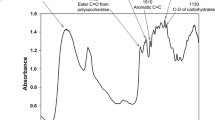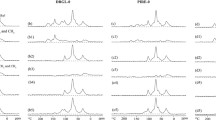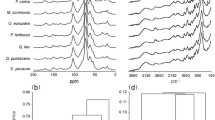Abstract
There is still a poor understanding of how changes in the organic composition of litter contribute to slowing or even cessation of decomposition. Using 13C nuclear magnetic resonance (NMR) spectroscopy of samples from the Canadian Intersite Decomposition Experiment (CIDET), we asked whether increasing lignin per se could account for the well-known increase in acid-unhydrolyzable residue (AUR), and secondly, using three litters from four sites with different mean annual temperatures, whether changes in organic composition would follow similar trajectories with C mass loss. At 6 years, there was 16–39% C remaining for 10 foliar litters and wood blocks at a site with rapid initial decomposition, and higher amounts remaining for three species at three colder sites. 13C NMR spectra obtained with rapid cross-polarization (CP) mainly showed increasing similarity among the foliar litters, although wood showed little change in composition. Foliage generally showed loss of O- and di-O-alkyl C, mainly from carbohydrate, and increase in alkyl, aromatic, phenolic and carboxyl C. However, O-alkyl C loss was limited, especially for litters with slow initial decomposition, and many litters showed relatively small changes in intensity distribution. Quantitative 13C (“BD”) spectra showed similar trends, but even smaller changes in C composition, and 6-year CP difference spectra showed that C was lost across the whole range of structures. Changes in δ13C were small and variable, but could be correlated to some extent with loss of carbohydrates versus tannins. Lignin was not selectively preserved, and the increase of resistant structures derived from lignin, tannins, and cutin collectively accounts for increasing AUR. Compositional changes of NMR C fractions across sites with different temperatures were small and inconsistent, likely due to the influence of other site factors; however, changes in their contents did largely follow consistent trajectories with %C remaining.









Similar content being viewed by others
References
Adair EC, Parton WJ, Del Grosso SJ, Silver WL, Harmon ME, Hall SA, Burke IC, Hart SC. 2008. Simple three-pool model accurately describes patterns of long-term litter decomposition in diverse climates. Global Change Biol 14:2636–60.
Alarcón-Gutiérrez E, Floch C, Ziarelli F, Albrecht R, Le Petit J, Auger C, Criquet S. 2008. Characterization of a Mediterranean litter by 13C CPMAS NMR: relationships between litter depth, enzyme activities and temperature. Eur J Soil Sci 59:486–95.
Almendros G, Dorado J, González-Vila FJ, Blanco MJ, Lankes U. 2000. 13C NMR assessment of decomposition patterns during composting of forest and shrub biomass. Soil Biol Biochem 32:793–804.
Amelung W, Flach KW, Zech W. 1999. Neutral and acidic sugars in particle-size fractions as influenced by climate. Soil Sci Soc Am J 63:865–73.
Baldock JA, Preston CM. 1995. Chemistry of carbon decomposition processes in forests as revealed by solid-state 13C nuclear magnetic resonance. In: McFee WW, Kelly JM, Eds. Carbon forms and functions in forest soils. Madison, WI: Soil Science Society of America. pp 89–117.
Balesdent J, Girardin C, Mariotti A. 1993. Site-related δ13C of tree leaves and soil organic matter in a temperate forest. Ecology 74:1713–21.
Berg B, Söderström B. 1979. Fungal biomass and nitrogen in decomposing Scots pine needle litter. Soil Biol Biochem 11:339–41.
Bowling DR, McDowell NG, Bond BJ, Law BE, Ehleringer JR. 2002. 13C content of ecosystem respiration is linked to precipitation and vapor pressure deficit. Oecologia 131:113–24.
Buchmann N, Kao W-Y, Ehleringer J. 1997. Influence of stand structure on carbon-13 of vegetation, soils, and canopy air within deciduous and evergreen forests in Utah, United States. Oecologia 110:109–19.
Davidson EA, Janssens IA. 2006. Temperature sensitivity of soil carbon decomposition and feedbacks to climate change. Nature 440:165–73.
de Montigny LE, Preston CM, Hatcher PG, Kögel-Knabner I. 1993. Comparison of humus horizons from two ecosystem phases on Northern Vancouver Island using 13C CPMAS NMR spectroscopy and CuO oxidation. Can J Soil Sci 73:9–25.
Derrien D, Marol C, Balabane M, Balesdent J. 2006. The turnover of carbohydrate carbon in a cultivated soil estimated by 13C natural abundances. Eur J Soil Sci 57:547–57.
Dria KJ, Sachleben JR, Hatcher PG. 2002. Solid-state carbon-13 nuclear magnetic resonance of humic acids at high magnetic field strengths. J Environ Qual 31:393–401.
Flanagan LB, Kubien DS, Ehleringer JR. 1999. Spatial and temporal variation in the carbon and oxygen stable isotope ratio of respired CO2 in a boreal forest ecosystem. Tellus 51B:367–84.
Garten CT Jr. 2006. Relationships among forest soil C isotopic composition, partitioning, and turnover times. Can J For Res 36:2157–67.
Grandy AS, Neff JC, Weintraub MN. 2007. Carbon structure and enzyme activities in alpine and forest ecosystems. Soil Biol Biochem 39:2701–11.
Guggenberger G, Christensen BT, Zech W. 1994. Land-use effects on the composition of organic matter in particle-size separates of soil: I. Lignin and carbohydrate signature. Eur J Soil Sci 45:449–58.
Harmon ME, Silver WL, Fasth B, Chen H, Burke IC, Parton WJ, Hart SC, Currie WS, LIDET. 2009. Long-term patterns of mass loss during the decomposition of leaf and fine root litter: an intersite competition. Global Change Biol 15:1320–38.
Herman J, Moorhead D, Berg B. 2008. The relationship between rates of lignin and cellulose decay in aboveground forest litter. Soil Biol Biochem 40:2620–6.
Johansson M-B, Kögel I, Zech W. 1986. Changes in the lignin fraction of spruce and pine needle litter during decomposition as studied by some chemical methods. Soil Biol Biochem 18:611–9.
Kannangara S, Parkinson D, Deshappriya N. 2007. Fungal biomass changes during the decomposition of leaves of Michelia nilagirica and Semecarpus coriaceae in an upper montane rainforest in Sri Lanka. Pedobiologia 51:158–68.
Kemmitt SJ, Lanyon CV, Waite IS, Wen Q, Addiscott TM, Bird NRA, O’Donnell AG, Brooke PC. 2008. Mineralization of native soil organic matter is not regulated by the size, activity or composition of the soil microbial biomass—a new perspective. Soil Biol Biochem 40:61–73.
Kirschbaum MUF. 2006. The temperature dependence of organic-matter decomposition—still a topic of debate. Soil Biol Biochem 38:2510–8.
Kögel I, Hempfling R, Zech W, Hatcher PG, Schulten H-R. 1988. Chemical composition of the organic matter in forest soils: 1. Forest litter. Soil Sci 146:124–36.
Kögel-Knabner I. 2002. The macromolecular organic composition of plant and microbial residues as inputs to soil organic matter. Soil Biol Biochem 34:139–62.
Kögel-Knabner I, Hatcher PG, Tegelaar EW, de Leeuw JW. 1992. Aliphatic components of forest soil organic matter as determined by solid-state 13C NMR and analytical pyrolysis. Sci Total Environ 113:89–106.
Lemma B, Nilsson I, Kleja DB, Olsson M, Knicker H. 2007. Decomposition and substrate quality of leaf litters and fine roots from three exotic plantations and a native forest in the southwestern highlands of Ethiopia. Soil Biol Biochem 39:2317–28.
Lorenz K, Preston CM, Raspe S, Morrison IK, Feger KH. 2000. Litter decomposition and humus characteristics in Canadian and German spruce ecosystems: information from tannin analysis and 13C CPMAS NMR. Soil Biol Biochem 32:779–92.
Mathers NJ, Jalota RK, Dalal RC, Boyd SE. 2007. 13C-NMR analysis of decomposing litter and fine roots in the semi-arid Mulga Lands of southern Queensland. Soil Biol Biochem 39:993–1006.
Melillo JM, Aber JD, Linkins AE, Ricca A, Fry B, Nadelhoffer KJ. 1989. Carbon and nitrogen dynamics along the decay continuum: plant litter to soil organic matter. Plant Soil 115:189–98.
Moore TR, Trofymow JA, Prescott CE, Fyles J, Titus BD, CIDET Working Group. 2006. Patterns of carbon, nitrogen and phosphorus dynamics in decomposing foliar litter in Canadian forests. Ecosystems 9:46–62.
Moorhead DL, Sinsabaugh RL. 2006. A theoretical model of litter decay and microbial interaction. Ecol Monogr 76:151–74.
Nault JR, Preston CM, Trofymow JA, Kozak L, Siltanen M, Titus B. 2009a. Applicability of diffuse reflectance Fourier transform infrared spectroscopy to the chemical analysis of decomposing foliar litter in Canadian forests. Soil Sci 174:130–42.
Nault JR, Preston CM, Trofymow JA. 2009b. Prediction of nuclear magnetic resonance carbon fractions in decomposing forest litter utilizing diffuse reflectance infrared Fourier transform spectroscopy and partial least squares regression. Soil Sci 174:249–57.
Newman RH, Theng BKG, Filip Z. 1987. Carbon-13 nuclear magnetic resonance spectroscopic characterization of humic substances from municipal refuse decomposing in a landfill. Sci Total Environ 65:69–84.
Nordén B, Berg B. 1990. A non-destructive method (solid state 13C NMR) for determining organic chemical components of decomposing litter. Soil Biol Biochem 22:271–5.
Osono T, Hobara S, Koba K, Kameda K, Takeda H. 2006. Immobilization of avian excreta-derived nutrients and reduced lignin decomposition in needle and twig litter in a temperate coniferous forest. Soil Biol Biochem 38:517–25.
Preston CM, Axelson DE, Lévesque M, Mathur SP, Dinel H, Dudley RL. 1989. Carbon-13 NMR and chemical characterization of particle-size separates of peats differing in degree of decomposition. Org Geochem 14:393–403.
Preston CM, Sollins P, Sayer BG. 1990. Changes in organic components for fallen logs in old-growth Douglas-fir forests monitored by 13C nuclear magnetic resonance spectroscopy. Can J For Res 20:1382–91.
Preston CM, Trofymow JA, Sayer BG, Niu J. 1997. 13C nuclear magnetic resonance spectroscopy with cross-polarization and magic–angle spinning investigation of the proximate analysis fractions used to assess litter quality in decomposition studies. Can J Bot 75:1601–13.
Preston CM, Trofymow JA, Niu J, Fyfe CA. 1998. 13C CPMAS NMR spectroscopy and chemical analysis of coarse woody debris in coastal forests of Vancouver Island. For Ecol Manage 111:51–68.
Preston CM, Trofymow JA, Canadian Intersite Decomposition Experiment Working Group. 2000. Variability in litter quality and its relationship to litter decay in Canadian forests. Can J Bot 78:1269–87.
Preston CM, Trofymow JA, Niu J, Fyfe CA. 2002. Harvesting and climate effects on organic matter characteristics in British Columbia coastal forests. J Environ Qual 31:402–13.
Preston CM, Bhatti JS, Flanagan LB, Norris C. 2006a. Stocks, chemistry, and sensitivity to climate change of dead organic matter along the Canadian Boreal Forest Transect Case Study. Clim Change 74:223–51.
Preston CM, Trofymow JA, Flanagan LB. 2006b. Decomposition, δ13C, and the “lignin paradox”. Can J Soil Sci 86:235–45.
Preston CM, Nault JR, Trofymow JA, Smyth C, CIDET Working Group. 2009. Chemical changes during 6 years of decomposition of 11 litters in some Canadian forest sites. Part 1. Elemental composition, tannins, phenolics and proximate fractions. Ecosystems, in press.
Qualls RG, Takiyama A, Wershaw RL. 2003. Formation and loss of humic substances during decomposition in a pine forest floor. Soil Sci Soc Am J 67:899–909.
Quideau SA, Graham RC, Feng X, Chadwick OA. 2003. Natural isotope distribution in soil surface horizons differentiated by vegetation. Soil Sci Soc Am J 67:1544–50.
Quideau SA, Graham RC, Oh S-W, Hendrix PF, Wasylishen RE. 2005. Leaf litter decomposition in a chaparral ecosystem, Southern California. Soil Biol Biochem 37:1988–98.
Schimel JP, Weintraub MN. 2003. The implications of exoenzyme activity on microbial carbon and nitrogen limitation in soil: a theoretical model. Soil Biol Biochem 35:549–63.
Smernik RJ. 2005. Solid state 13C NMR spectroscopic studies of soil organic matter at two magnetic field strengths. Geoderma 125:249–71.
Smernik RJ, Oades JM. 2000. The use of spin counting for determining quantitation in solid state 13C NMR spectra of natural organic matter 1. Model systems and the effects of paramagnetic impurities. Geoderma 96:101–29.
Smernik RJ, Oades JM. 2001. Background signal in solid state 13C NMR spectra of soil organic matter (SOM)—quantification and minimization. Solid State NMR 20:74–84.
Smernik RJ, Eckmeier E, Schmidt MWI. 2008. Comparison of solid-state 13C NMR spectra of soil organic matter from an experimental burning site acquired at two field strengths. Aust J Soil Res 46:122–7.
Spielvogel S, Prietzel J, Kögel-Knabner I. 2007. Changes of lignin phenols and neutral sugars in different soil types of a high-elevation forest ecosystem 25 years after forest dieback. Soil Biol Biochem 39:655–68.
Trofymow JA, CIDET Working Group. 1998. The Canadian Intersite Decomposition Experiment (CIDET): Project and Site Establishment Report. Information Report BC-X-378. Canadian Forest Service, Pacific Forestry Centre, Victoria, BC.
Trofymow JA, Preston CM, Prescott CE. 1995. Litter quality and its potential effect on decay rates of materials from Canadian forests. Water Air Soil Pollut 82:215–26.
Wilson MA, Heng S, Goh KM, Pugmire RJ, Grant DM. 1983. Studies of litter and acid insoluble soil organic matter fractions using 13C-cross-polarization nuclear magnetic resonance spectroscopy with magic angle spinning. J Soil Sci 34:83–97.
Wynn JG, Bird MI, Wong VNL. 2005. Rayleigh distillation and the depth profile of 13C/12C ratios of soil organic carbon from soils of disparate texture in the Iron Range National Park, Far North Queensland, Australia. Geochim Cosmochim Acta 69:1961–73.
Zech W, Johansson M-J, Haumaier L, Malcolm RL. 1987. CPMAS 13C NMR and IR spectra of spruce and pine litter and of the Klason lignin fraction at different stages of decomposition. Z Pflanzenernähr Bodenk 150:262–5.
Zhang CF, Meng F-R, Trofymow JA, Arp PA. 2007. Modeling mass and nitrogen remaining in litterbags for Canadian forest and climate conditions. Can J Soil Sci 87:413–32.
Acknowledgements
The Canadian Intersite Decomposition Experiment (CIDET) Working Group is a group of researchers cooperating in a 12-year study of litter decomposition, and who provided the litter samples reported in this paper. We also thank Ann Harris (PFC) for C and N analyses and the Climate Change and Ecosystem Processes Networks of the Canadian Forest Service for support. Further information on CIDET is available on the web at www.pfc.cfs.nrcan.gc.ca/climate/cidet.
Author information
Authors and Affiliations
Corresponding author
Additional information
Author Contributions
Tony Trofymow is the leader of the whole CIDET study, Caroline Preston was the lead author and did all of the NMR and initial spectral analysis, but both Jason Nault and Tony Trofymow contributed heavily to data analysis, writing, figures and revisions.
Rights and permissions
About this article
Cite this article
Preston, C.M., Nault, J.R. & Trofymow, J.A. Chemical Changes During 6 Years of Decomposition of 11 Litters in Some Canadian Forest Sites. Part 2. 13C Abundance, Solid-State 13C NMR Spectroscopy and the Meaning of “Lignin”. Ecosystems 12, 1078–1102 (2009). https://doi.org/10.1007/s10021-009-9267-z
Received:
Revised:
Accepted:
Published:
Issue Date:
DOI: https://doi.org/10.1007/s10021-009-9267-z




